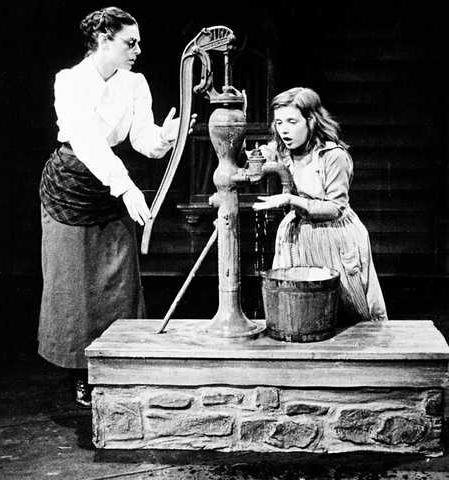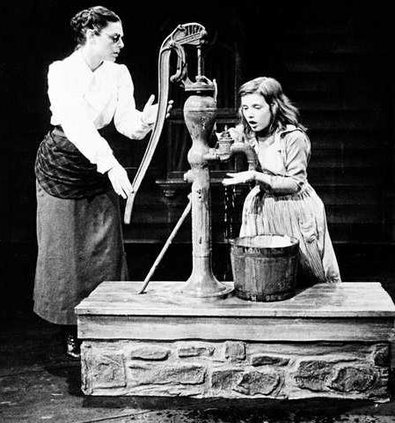‘The Miracle Worker’
Starring: Patty Duke and Anne Bancroft
Running time: 106 minutes
Rated: Not rated in U.S.
When renowned actress Patty Duke died two months ago, I was a bit ashamed. I had never seen any of her films.
After numerous suggestions, I decided to watch one of her most famous movies, “The Miracle Worker.”
After a two-year stint on Broadway, this 1962 film launched Duke to stardom, earning her an Academy Award for best supporting actress at the age of 16 — the youngest to ever win an Oscar at the time.
Duke’s portrayal of Helen Keller, the famous deaf and blind girl who struggled to learn how to communicate, is the best child performance I have ever seen.
The film encompasses Helen’s childhood and education under Annie Sullivan (Anne Bancroft). Helen grew up on an Alabama plantation home in the late 1800s. Her family, while caring, struggled to communicate with a girl who could only sense touch and smell. As a result, Helen became used to getting her way on everything.
At their wit’s end, the family contemplates institutionalizing Helen, though her mother is horrified at the prospect of forcing the girl to live among the squalor and neglect that were the asylums of the time. As a last-ditch effort, the family enlists the help of Sullivan, a headstrong and near-blind graduate from the Perkins School for the Blind.
Helen immediately clashes with the older woman. While the family always gives in to the girl’s desires because they do not have the patience or knowledge to teach her, Sullivan holds no quarter. At meals, Helen wanders and eats off other’s plates, until Sullivan picks her up and forces to sit in her own chair. When angered, Helen strikes violently with kicks and slaps, until Sullivan restrains her or strikes back.
In fact, a large portion of the film is dedicated to Sullivan literally wrestling with the girl to teach her manners and obedience. This hard-line approach quickly runs afoul of the Keller family, who view it as a brutal and disruptive method that will certainly fail.
The results soon surprise them. After a few weeks, Helen sits in her own chair to eat a meal from her own plate and even folds her napkin when she finishes. But Sullivan wants more. Manners can be taught with punishment and rewards, but language and communication is far more difficult.
Even during the rough and tumble lessons on manners, Sullivan always shows Helen how to use sign language. Every time the girl picks something up, Sullivan holds her hands and demonstrates the sign. She teaches the girl how to recognize facial expressions by touch. She teaches her what sad, happy and approval looks like.
Helen learns many signs and regularly shows them off, but she still doesn’t understand the signs were names for real things.
How do you teach someone who has never communicated through language that everything has a name?
Sullivan knows how to handle Helen’s tantrums and the doubting family, but this question haunts her. She refuses to abandon Helen to a life of well-mannered ignorance. She wants to teach her language, how to read, how to communicate and even how to talk.
While Duke wins most of the praise for this film, Bancroft also delivers a stunning performance and earned an Oscar for it. She embodies the stern Northerner who doggedly refuses to accept less for Helen than what an able-bodied person is capable.
From behind her round sunglasses, she stares down “Captain” Arthur Keller whenever he admonishes her teaching methods. She is the only person to tell off the doting Kate Keller for enabling her daughter’s bad behavior. But even during particularly rough sessions with Helen, she has a tenderness that can only exist between a teacher and student.
Bancroft’s skill makes Duke seem that much more talented because the young star steals the show. At times, it is easy to forget Duke is actually fully able to see and hear as she seems genuinely bewildered during lessons. But she never slips into a stereotypical depiction of a girl running wild, flailing her arms in front of her. Keller may have been blind, but she knew her house and her surroundings. She could still play tricks and lock her teacher in her room.
All these parts that make a good movie — nice settings and skilled cinematography — are present in “The Miracle Worker.” But it is a film borne on the back of two gifted actresses. Duke and Bancroft may be gone, but they left a permanent mark on American cinema.
“The Miracle Worker” is available on Amazon Video for $2.99-$12.99.
Andrew Akers is a columnist for The Times. He can be reached at andrewpakers@gmail.com.

